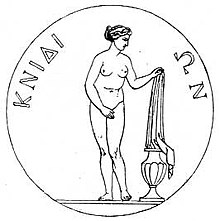Aphrodite of Knidos
The Aphrodite of Knidos , also Knidische Aphrodite , is one of the most famous works of the Attic sculptor Praxiteles . The statue was probably made between 350 and 340 BC. BC and establishes the type of Venus pudica ( shameful Venus , since she covers her shame with her right hand, and in later versions sometimes her breasts) in ancient art. It was placed in a temple in Knidos .
original
The statue was famous for its extraordinary beauty, which could be admired from all sides (panoramic view), as well as for being the first life-size representation of the naked female body in classical times. The goddess Aphrodite was depicted preparing for the ritual bath to restore her virginity; in her left hand she holds her robe while she hides her shame with her right hand.
Pliny informs that Praxiteles had received an order from the citizens of Kos to build a statue of the goddess Aphrodite. The sculptor then made two versions: one fully clothed and one completely naked. The shocked residents of Kos would have rejected the nude and chose the clothed version. The appearance of the clothed statue is not known. Since there are no contemporary reports about it, it does not seem to have been particularly noteworthy. The unclothed idol that was rejected was then acquired by some inhabitants of Knidos and placed in a specially built temple, which made it possible to view the statue from all sides. Due to the revolutionary depiction of the goddess in complete and self-confident nudity, she quickly became one of the most famous works of Praxiteles. Pliny writes:
- “The Venus des Praxiteles surpasses all works of art in the whole world. Many have made the sea voyage to Knidos just to see this statue. "
Allegedly the hetaera Phryne Praxiteles served as a model for the statue, which gave further nourishment to the myth of its creation. The statue became so well known and widely copied that legend has it that the goddess Aphrodite came to Knidos herself and then asked: "Where did Praxiteles see me naked?"
As a cult image and patron saint of the Knidier, the statue quickly became a tourist attraction. Nicomedes I of Bithynia once offered to pay the enormous debts of the city of Knidos in exchange for the statue, but the Knidians refused. According to tradition, the figure was so lifelike that a young man let himself be locked in the cella of the temple and tried to associate with her. The result of these efforts was an indelible stain on the back of a thigh, which apparently actually existed and could have given rise to this story.
A dialogue in Pseudo-Lucian contains the most vividly preserved description of the Temenos , the temple precinct, Aphrodite on Knidos. The author writes profusely about the statue itself:
- When we got tired of the beauties of this place, we were in a hurry to get to the temple itself. The goddess stands in its midst; her statue is made of Parian marble . Your lips are slightly parted with the hint of a smile. Nothing obscures her beauty, which is perfectly depicted, save a hand that stealthily covers the shame. The art of the sculptor has succeeded in removing the hardness of the marble and thus shaping the grace of its limbs. (Pseudo-Lukian, Erotes 15)
The statue of the goddess is also praised in epigrams .
Copies

The original of Aphrodite of Knidos has not survived. It may have been brought to Constantinople in late antiquity , where it was lost in a fire during the Nika uprising . However, since it is one of the most frequently copied works of art from antiquity - more than 50 large-scale copies have survived - its original appearance can be at least approximately reconstructed on the basis of the descriptions and copies that have been preserved. In 1969 , the archaeologist Iris Love believed that some of the fragments kept in the British Museum's depots belonged to the original of the Knidia, but science today safely assumes that these are the remains of another statue.
- Probably the most faithful surviving copy is the so-called Venus Colonna in the Museo Pio-Clementino of the Vatican Museums
- The Kaufmann's head in the Louvre is regarded as a very faithful Roman replica of the head of Knidian Aphrodite.
- In Hadrian's Villa near Tivoli there was a replica of the Knidic Temple, with an only fragmentary statue of Aphrodite in its center. This essentially corresponds to the well-known ancient information for the installation of the original.
In addition to these relatively exact copies, there are also a large number of surviving variants that are also based on a reception of the Knidian Aphrodite, such as the Capitoline Venus .
literature
- Theodor Kraus : The Aphrodite of Knidos. Walter Dorn Verlag, Bremen / Hanover 1957.
- Leonard Closuit: L'Aphrodite de Cnide. Etude typologique des principales répliques antiques de l'Aphrodite de Cnide de Praxitèle. Imrimerie Pillet, Martigney 1978.
- Francis Haskell , Nicholas Penny : Taste and the Antique. The Lure of Classical Sculpture, 1500-1900. Yale University Press, New Haven / London 1981 (on reception history).
- Christine Mitchell Havelock: The Aphrodite of Knidos and Her Successors. A Historical Review of the Female Nude in Greek Art. University of Michigan Press, Ann Arbor MI 1995, ISBN 978-0-472-03277-8 ( digitized ).
Web links
- Entries on Aphrodite of Knidos in the Arachne archaeological database
- Page with a photo and a reconstruction of the Temple of the Knidian Aphrodite in Hadrian's Villa in Tivoli
Remarks
- ↑ Pliny, naturalis historia 36, 20.
- ↑ Pseudo-Lukian, Erotes 13.
- ↑ Pliny, naturalis historia 36, 20.
- ↑ Athenaios , Deipnosophistai 13, 59.
- ↑ Pliny, naturalis historia 36, 20; Valerius Maximus 8, 11, ex. 4th
- ↑ Anthologia Graeca 16, 160, 162, 163, 168.


